




Smooth Sailing



































Embarking on the open water is an exhilarating experience, flled with the promise of adventure and relaxation. Whether you’re a seasoned sailor or a weekend cruiser, protecting your vessel with proper insurance is not just a choice—it’s a necessity. Explore the reasons why every boat owner should prioritize boat insurance for a worry-free voyage.
The open water can be unpredictable, with unexpected storms, collisions, or other potential accidents. Boat insurance can give you fnancial protection if there is damage to your vessel, providing coverage for repairs or replacement.
Accidents on the water can result in damage to other boats, docks, or even injuries to passengers. Boat insurance offers liability coverage, which can pay for damages or injuries you’re liable for while boating, up to specifed limits, and lawsuit costs if you’re sued. This includes damage you cause to another watercraft or if someone on or near your boat is injured and you’re found to be legally responsible.
Unfortunately, boat theft and vandalism are realities that boat owners face. Boat insurance has comprehensive and collision coverage that can protect you against events outside of your control, including theft and vandalism.
Accidents on the water may lead to injuries for you or your passengers. Boat insurance offers a range of optional medical payments coverage limits, helping to cover medical expenses if you are in an accident or someone is hurt on your boat, regardless of fault.
If you fnanced the purchase of your boat, most lenders require insurance coverage to protect their investment. Having boat insurance not only fulflls these requirements but also gives you peace of mind knowing that your fnancial interests are safeguarded.


Some water municipalities and marinas may require proof of insurance for docking or accessing certain areas. Boat insurance allows you the fexibility to explore different destinations without worrying about entry restrictions.
Emergency towing and assistance
Progressive boat insurance can include optional Sign & Glide® On-Water Towing coverage. If your boat is disabled or breaks down on the water, Sign & Glide® pays for on-water towing, jump starts, soft un-groundings, and fuel delivery.
Wreckage removal
If your boat sinks, Progressive boat insurance will cover the cost of removing your boat from the water (if removal is legally required).
Investing in boat insurance is not just about protecting a valuable asset; it’s about safeguarding the memories, experiences, and joy that come with your on-water adventures. Don’t let unforeseen circumstances disrupt your journey—navigate with confdence, knowing that Progressive boat insurance has you covered. Ensure a smooth and worry-free voyage, because when it comes to your boat, peace of mind is the ultimate luxury.
Scan to get a quote in as little as 4 minutes
learn more.





















By Ben Martin, Editor in Chief
Fishing is a beloved pastime that transcends borders, drawing anglers to new destinations around the globe. Whether it’s the thrill of chasing trophy !sh, exploring pristine environments, or immersing oneself in local cultures, traveling to !sh o ers a unique and enriching experience. But why do so many anglers feel compelled to venture far from their home waters to cast a line? Here are some key reasons behind this phenomenon.
For many anglers, the chance to catch a once-in-a-lifetime !sh is a driving force behind their travels. Di erent regions are home to speci!c species that can’t be found elsewhere. For example, the tarpon-rich waters of the Florida Keys, the salmon runs in Alaska, or the giant trevally in the Seychelles all serve as magnets for anglers. e challenge of targeting these iconic species and the bragging rights that come with landing them o en justify the journey.

requires anglers to adapt and learn. Di erent locations come with unique !shing techniques, such as y !shing in Montana’s rivers, jigging for tuna in o shore waters, or using traditional handlines in tropical locales. Each trip is an opportunity to
friends and family or encounters with local guides and fellow anglers. ese interactions create lasting memories and a sense of camaraderie that extends beyond borders. In turn, the stories and photos from these adventures become cherished mementos, sparking conversations and inspiring others to pursue their own !shing journeys.
Magazine and its digital magazine Magazine have always tried to bring you news and awareness about exotic !shing destinations around the world. Your trips and adventures are an integral part of our monthly compilation process. Your photos, videos and stories about your !shing trips are always welcomed here.

acquire new skills, re!ne existing ones, and deepen one’s appreciation for the art and science of !shing.
Fishing in new destinations allows anglers to experience a variety of ecosystems, each with its unique beauty and challenges. From tranquil mountain streams and sprawling freshwater lakes to turquoise saltwater ats and deep ocean trenches, the diversity of !shing environments is staggering. is variety not only enhances the adventure but also broadens an angler’s understanding of aquatic habitats and their importance to global biodiversity.
Traveling to new !shing destinations o en
Fishing inherently fosters a deep connection with nature, but traveling ampli!es this experience. Anglers o en !nd themselves in remote, untouched locations where the tranquility and beauty of the natural world are at their peak. is immersion provides a welcome escape from the stresses of daily life and fosters a sense of mindfulness and gratitude.
Fishing trips o en bring people together, whether it’s through shared experiences with
For many anglers, !shing is more than a sport—it’s an adventure. Traveling to new destinations satis! human desire to explore the unknown and conquer its challenges. Whether it’s navigating unfamiliar waters, encountering unpredictable weather, or matching wits with elusive !sh, each trip is a thrilling chapter in an angler’s personal story. e reasons anglers travel to as diverse as the destinations they seek. From the pursuit of trophy catches to the joy of exploring new landscapes, each journey o ers a blend of excitement, education, and enrichment. For those who !sh, the world is not just a playground but a treasure trove of opportunities waiting to be discovered. So, pack your gear, book that trip, and embrace the adventure—the next big catch might be just a plane ride away.
To submit your catch photos, videos or stories, email editorial@coastalanglermagazine.com.
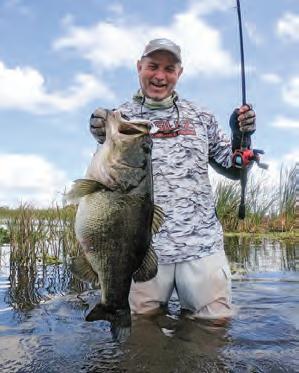















You want new charts?
You got new charts! Explore the ocean with vibrant terrain & depth shading, using all-new TZ MAPS. Don’t just take our word for it. See for yourself. Scan here, and we’ll show you!

What started as a morning of unproductive wahoo trolling north of St. Augustine turned into an unforgettable battle with one of Florida’s most prized catches. Capt. Daniel Levesque and his crew aboard Rare Breed had spent hours searching for wahoo, battling against an uncooperative west wind, when they decided to switch tactics.
“A er passing over endless schools of blue runners and proli!c bottom structure, I pulled into a spot that had previously produced wahoo,” recalls Capt. Daniel. “ e sonar was marking !sh from top to bottom.”
By Brandon Shoaf


As two anglers at the bow dropped sabiki rigs to collect live bait, their lines became hopelessly entangled. While the captain worked to untangle the mess of braided line, angler Mike Lorenz noticed something interesting on the sonar screen. He dropped down an old, paint-worn butter y jig to about 60 feet.
“It got hit by what felt like a train,” Lorenz describes. “ e conventional reel was screaming. At !rst, I thought I had a shark, but it felt di erent.” e mystery !sh made several blistering runs, nearly spooling Lorenz’s reel multiple times. e battle switched between long runs and deep, powerful dives under the boat. “It felt more like !ghting a huge grouper when it was beneath us,” says Lorenz. “I think both the !sh and I were taking breaks between rounds.”
Capt. Daniel maneuvered the boat to help chase down the !sh. A er an
9.9/15/20
These compact yet powerful engines have all the features you would expect to see on larger outboards, such as bettery-less EFI technology, multi-function tiller handle* and a large displacement porviding outstandng power. All while maintaining lightest in its class, quiet opetration and ease of portability.
intense !ght, a massive silver ash appeared near the surface, prompting the captain to shout “AP!” e prize—a massive African pompano—was !nally secured with a well-placed ga shot by Capt. Daniel. e crew gathered for photos, marveling at their spectacular trophy, a testament to both the !sh’s size and the memorable nature of the catch.
What began as a “cursed” day of wahoo !shing transformed into the catch of a lifetime, proving once again that sometimes the best !shing stories come when plans go sideways and anglers remain ready for whatever opportunity presents itself.
Brandon Shoaf is Co-Publisher of Coastal Angler Magazine’s Volusia County edition. Contact him at (386) 260-9600 or volusia@coastalanglermagazine.com.




















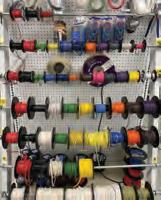




















By Brandon Tourigny
In the northern parts of our great country, anglers enjoy chasing down enormous pike and elusive musky. We Floridians don’t usually give this toothy family of sh a second thought since the lake monsters of the north are nowhere to be found in our waters. ere is, however, a smaller cousin of northern pike and musky that Florida anglers willing to do a little searching can have the pleasure of shing for: the chain pickerel.
Named for their greenish and dark colorations creating a chainlike pattern, these sh stand out among the pike family. Alongside their smaller relative, the red n pickerel, these are the only pike family members commonly found in Florida.
Chain pickerel are found statewide and most o en inhabit densely vegetated areas of ponds, swamps and rivers. ese predatory sh are solitary hunters that prowl the shallows in search of small minnows and shad. e chain pickerel’s lightning-fast strikes and long snake-like body make for an exhilarating battle on lighter tackle. e best place to start in terms of selecting baits would be to go with small Rapala jerkbaits and crankbaits, topwater plugs and spinnerbaits. To be able to fully appreciate the ght in these feisty predators, a good rod and reel set up would be a medium-light action spinning rod paired with a 2,500 to 3,000 size spinning reel spooled up with 10- to 20-pound braided line. Don’t be surprised, however, if these toothy sh cut you o$ on occasion. eir mouths are full of needle-sharp teeth that can tear through shing line, and your ngers, very easily.
If you are looking to gain some recognition for your chain pickerel, be sure to check out the Florida Fish and Wildlife Conservation Commission’s big catch program, which gives wellearned recognition to large sh of a number of species caught in Florida. In terms of chain pickerel, any sh 3 pounds and heavier will qualify for this program. Also, as I always like to remind anglers across Florida, these sh are a native species to our state and deserve our respect when shing for them. Try to return sh unharmed to the water as quickly as possible to ensure your catch can continue to grow and carry on the population so our children a er us can have the chance to catch these magni cent sh.
Recommendations include $30 million to Restore Apalachicola’s Oyster Habitat, $10 Million for Shooting Sports Facilities, and $10 million for Artificial Reefs
Governor Ron DeSantis recently announced his 2025-26 Focus on Fiscal Responsibility Budget recommendations, solidifying Florida’s status as the nation’s leader in sh and wildlife conservation and outdoor recreation.
“Governor DeSantis’ recommendations reinforce his unwavering support to Florida’s sheries, hunting and angling community, public access to shooting sports, and the long-term recovery of the Apalachicola Oyster Habitat,” said FWC Executive Director Roger Young. “ ese investments are in addition to the Governor’s law enforcement pay plan, support of enhanced training capabilities for FWC O cers, and funding to bolster our operations to combat illegal immigration and drug tra cking.”
Florida is home to some of the country’s premier destinations for top-tier shing, hunting, and outdoor recreational opportunities. ese activities draw outdoor enthusiasts to our state and contribute signi cantly to the state’s economy with nearly $15 billion dollars. With more than 34 million acres of public and private land and over 12,000 square miles of water, maintaining our sh and wildlife resources is critical to sustaining a healthy way of life and a robust economy.
• Restoring Apalachicola Bay Oysters:
Historically, nearly 90% of Florida’s and 10% of the nation’s wild oysters came from Apalachicola Bay. is year, the Governor is recommending $30 million in funding to expedite FWC’s e$orts to restore and recover the oyster habitat. is investment is in addition to an additional $10 million investment in the Department of Environmental Protection’s budget to invest in projects that support the Apalachicola Bay Area of Critical State Concern.
• Promoting Floridians’ Access to Public Boat Ramps: As the Boating Capital of the World, Florida’s coastal communities must have enough publicly accessible boat ramps. As such, the budget recommends $9 million to increase public access to maritime facilities while providing another year of %exibility in the Department of Environmental Protection’s Working Waterfronts program.
• Investing in Florida’s Arti cial Reefs: e Focus on Fiscal Responsibility Budget provides $10 million to support additional reefs across Florida’s coastlines.
• Increasing Public Access to Shooting Sports and Wild Game: e Governor’s Budget invests $9.2 million to support the construction of two new shooting sports facilities in Liberty and Polk counties while also calling for a “Second
Amendment Summer” tax holiday on rearms and ammunition. Additionally, the budget provides $9 million to manage FWC’s wildlife management areas.
• Prioritizing Fresh and Saltwater Research and State Management: As recommended by the Governor, FWC is provided additional funds to support FWC’s marine lab in Cedar Key and increased funding to support the management of Red Snapper o$ all of Florida’s coastlines. e budget also prioritizes investments in Florida Bass, Snook, Tripletail, and other Bone sh species.
• Defending Florida’s Everglades from Invasive Species: Governor DeSantis includes more than $3 million to remove pythons from the Everglades utilizing traditional methods and innovative technologies.
• Maintaining Law & Order: e Governor provides $5 million for a dedicated state training facility for waterborne rescues and $4.4 million to codify the FWC’s Special Immigration Law Enforcement Unit.
FWC’s mission is to manage sh and wildlife resources for their long-term well-being and the bene t of the people. To learn more about FWC, visit MyFWC.com.



By: Caitlyn Gatrell

Hello fellow outdoor lovers! A new month brings new adventures, and what better way to spend some quality nature-filled time than spending a night outdoors. To make it even better, spend a night on an island! It might take you out of your comfort zone a bit, but it's well worth it. Being immersed in nature while surrounded by marine life and the sound of crashing waves is something special. I recently took a weekend trip out to the islands with my crew, and it was quite the adventure!
I will say it does take a bit of prep and work to go island camping. You have to load up all the necessary gear, like your tent, clothes, toiletries, chairs, firewood, food, drinks, etc, and of course your fishing gear. We typically will get ready a couple days beforehand, that way when it's time to ride out we are all ready to go. Setting up camp can be some work, but once it's all finished it's a great feeling.
Once we got out there and got our camp set up, we headed out for some fishing. We took a ride to some of the local mangrove lines and points, seeing who was hanging around. Despite it being winter, the scenery was gorgeous and the weather was nice. We hooked up to and caught species like redfish, seatrout, and snapper.
It was pretty cool to fish for a bit and then head back to camp for sunset, as we fileted and grilled our catches. Watching the sun set over the water as the wildlife gets active for its evening bite is also a sight to see too. We even brought our pups along for this adventure, where they got to join in the fun. We played games, went swimming, and even went wade fishing during the day and from shore at night. Some seatrout and sharks were caught, adding to the excitement. We also watched the beautiful stars in the night sky as we sat around our campfire exchanging stories.
Clean up time is probably the hardest part of the trip, but as I always say, leave it how you arrived. Throughout exhaustion from the heat and long weekend, we moved slower than before but ensured our island was clean and ready for its next guests. I recommend everyone try island camping out, at least once in your life! It truly is a fulfilling and fun journey, one that I would do again in a heartbeat!
By: Capt. Tim Ramsey

Icannot believe I’m saying this, but about thirty-five years ago, I had the pleasure of owning the most versatile boat in the world. Yes, the one boat in my history that I truly wish I still had. The one boat that rose to the surface in the mix of flats boats, bay boats, offshore boats, Jon boats and skiffs I have had. That boat was the original 13’ Boston Whaler.
The boat is legendary. Stable as a dock. Able to carry four adults and run on-plane with only a 1984 35 horsepower Johnson two-stroke outboard. Stable enough to stand at the gunwale and fight a fish. Simplicity at its finest. No thru hulls. No jack plate, power pole, anchor winch, roller, windshield, bilge pumps, or trim tabs. One hatch in the bow, mahogany planks for seats, little mahogany side console with one battery underneath, cable steering (more aptly described as pulley and plastic-coated wire steering), stainless wheel, throttle box mounted on the inside of the gunwale and a long, narrow twelve-gallon gas tank under the rear bench. It was awesome, and it thought it was much more than it was. We fished with it, clammed and crabbed with it, went exploring and bar hopping, rode waves in the inlet, pulled skiers and surfboards behind it, and even went trolling offshore.
I kept it on a galvanized Shorelander trailer that had an articulating tongue, a hinge in the middle that let me launch it sometimes off the side of the road where the jet ski’s launched. The jet ski types used to look at me funny towing the boat with an old Honda Accord sedan, but it didn’t need anything bigger. They didn’t know I was launching it on the side of the Honeymoon Island Causeway as a shortcut to go out to the 3-mile reef and catch grouper, using my handheld military compass and “Top Spot” chart to navigate.
I once entered a kingfish tournament off the coast of Jacksonville. There I was, nine miles out, fishing for king mackerel like anyone else. I had installed two rod holders behind the rear bench seat and was able to troll out and back. While I was fishing, a big Hatteras sportfish came by, and the owner yelled over to me “what are you doing out here?” I thought the answer was obvious. However, I replied “I’m looking for a farmer’s market in Tennessee.” Then he asked, “what do you do if your boat sinks?” I retorted “what do you do if yours sinks?” as I pointed at the bow of his boat where he kept a 13’ Whaler on the front deck. Quick reminder of an unsinkable hull. He then used a boathook to pass me a Ziploc bag with a couple hot dogs in it and bid me farewell. At the end of the day, I miraculously got fourth. He got eighth. Ironically, if I had gotten third, the prize was a 13’ Whaler.
Years earlier, that boat was the perfect craft to buzz tourists in southern New Jersey. We would ride along the beach, turn in when the waves went slack, race toward the beach like lunatics, then at the last moment in about ten inches of water, make a U-turn and race back out. Yeah, I know, but we were kids. We would spend the day crabbing in the back bay, wade for chowder clams, drink as many mini-Lowenbrau’s as we could fit in the boat, ski in the marsh canals, and generally goof off. Good times.
Once summer was over, we would sneak out of Corson’s Inlet, a non-maintained inlet on the southern end of Ocean City, New Jersey, and troll for bluefish seven miles down Sea Isle City’s beach to Townsend’s Inlet, then go back inside the Intercoastal. Strange going from surfing shorts and flip flops to jackets and sweatpants using the same little boat.
Little boats like that teach you things both practical and in life. I learned how to self-maintain a boat because it was small, very simple, and oddly, old enough. How did I learn to replace the engine’s manual tilt lever? Once it corroded off the motor mount and fell on the ground, I took it to the parts store and said, “I need one of these.” Then I went back and put it on. Manual shift lever? Same thing. How did I figure out replacing the weird steering cable? Remember Polaroids?
This was where I first experimented with compounding, buffing, and painting fiberglass, applying bottom paint, fixing gelcoat, reinstalling rub rails, removing rust stains, refinishing wooden seats, maintaining batteries, running wiring, heat shrinking, maintaining a trailer, and the list goes on. I also learned that back then even “waterproof” trailer lights were never actually waterproof. Remember trailer bulbs? Yeah, what fun.
This little boat also taught me about being responsible for the safety of others. It taught me how to run a boat smoothly, how to run in a chop and over wakes so people didn’t bounce or go unnecessarily overboard, the boat didn’t get swamped, roll over or punch through a wave. The Whaler still teaches me things. Less is more, don’t tell my wife! Simpler is better. Standing on the bow back in the mangroves with a small trolling motor mounted on a paddle held in place by C-clamps with ten feet of boat behind me worked just as well as my 22 Skeeter with a powerful three battery professionally rigged trolling motor and twenty feet of boat behind me. I can pole a 13 Whaler. I am not poling a 22 Skeeter, and you can get lost in the backcountry even easier in a 13’ Whaler than in a 22 Skeeter.
The memory of that little boat and our antics in it taught me life was good back then, and good along the way. I grew up in that thing, and it was the first boat my son ever drove. He would stand behind the wheel that was waist high to him at three years old, huge grin on his face, and shove that throttle as far as it would go. He had one speed, full blast, which would describe the next twenty years of his life. That is a memory I will never forget. Now over thirty, he somehow remembers that Whaler, and man can he catch a fish. Did I say the boat is legendary? It even features in two of my mystery novels, “Unnecessary Evils” and “The Deadly Tropic Snow.”
Ci nderella said it best. No, not from the fairy tale, the guys from the rock and roll 80’s “hair band.” They said, “You Don’t Know What You Got Till It’s Gone.”
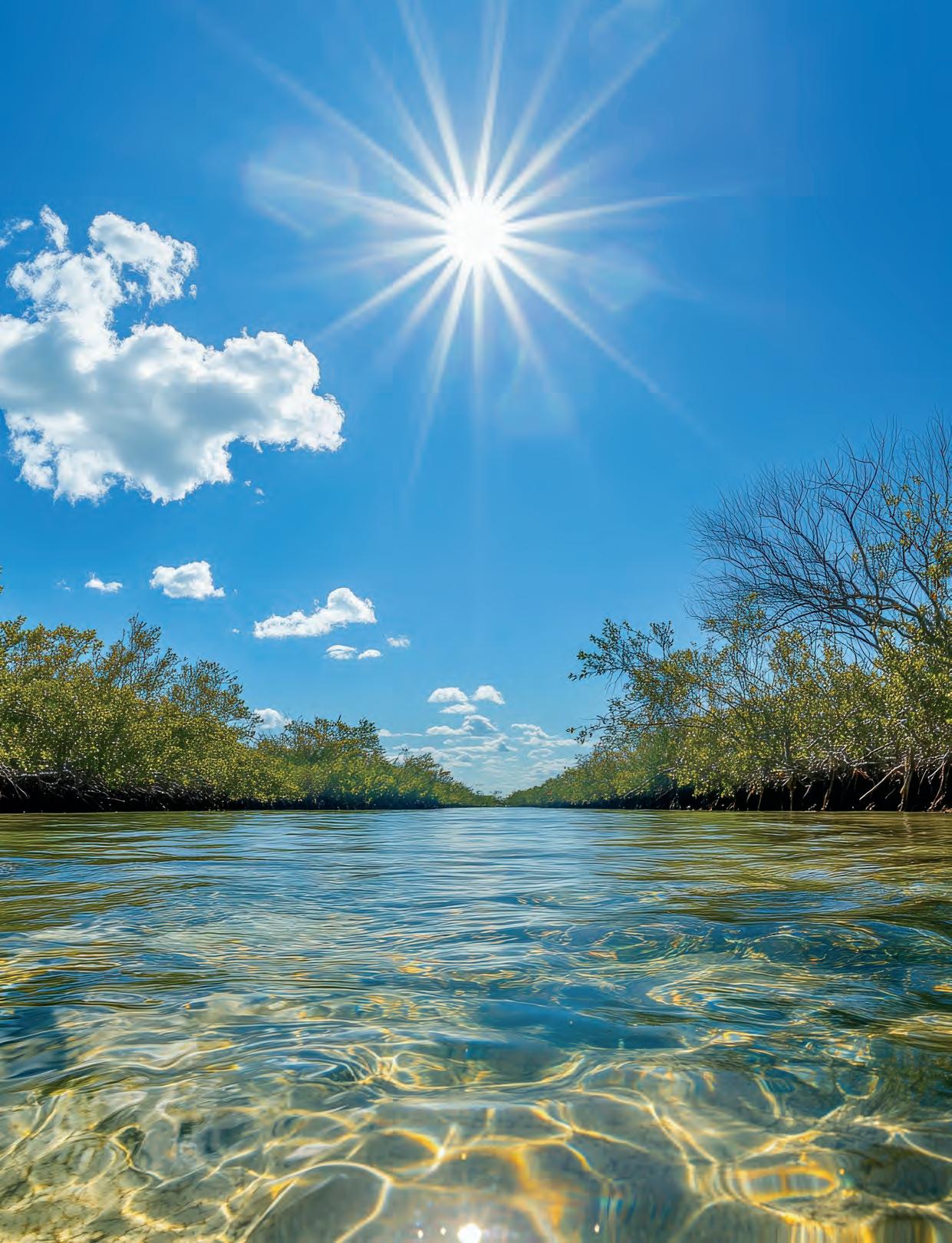




By: Jessica Hendrie

About a week ago, I went fishing in Fort Lauderdale with Happy Day Today Fishing Charters by Top Shot Fishing in hopes to catch sailfish. Weather was perfect, ideal for big sails. And maybe even a few wahoo. The crew and I tried and tried, trolled and trolled more and more. We put the kites out, loaded up on the goggle eyes, played with the lines for hours and so on. But you know how it goes, not every trip out will land you a fish. Although we may have hooked one or two, nothing ever made it to the boat. Oh well, big deal. It happens. We eventually decided to bottom fish in hopes to catch a snapper or two. I caught a small king fish earlier in the day so that was perfect cut up for bait and within minutes, the snapper started biting. Then the sharks started getting bad. Story of my life. Sharked. Sharked. Sharked. 1 fish. Sharked. After some time of that, I needed something different, and I grabbed the trusted slow pitch. I think you knew where this was headed already. The slow pitch is known to catch any and everything. It’s a smaller rod with a jig that you let flutter down. And boy does it work. I’ve caught so many things using it such as tuna, king fish, even wahoo. Well, this time I figured I’d probably catch those or a barracuda but I didn’t except to catch this big of a barracuda. I’m 5’2 and it was nearly as big as me. I’m so surprised I was able to get it on the boat without it breaking the line with its teeth. But here we are. I did it. He was about 100 feet down and wacked it. Boom! At first, I thought it was a kingfish, maybe. I saw black and purple and he was all lit up and once I saw it was a huge barracuda, it was such a rush. After I got him into the boat, I snapped a few quick photos and successfully released him so he could live another day. The jig was mangled once he was done with it. After that experience, it’s safe to say it was a successful trip out. Happy Fishing!



By: Joe Sheaffer

After having my boat in the shop for a few weeks, I was itching to get back out on the water. I launched my boat and wouldn’t you know it, my boat wasn’t working correctly. Well, I was in the water and my trolling motor was fully functioning, so I was going to go fishing. I was limited in the area where I could fish, I looked for areas that had different types of structure in close proximity. I found a flat adjacent to a channel that had some rip rap against the bank. I zeroed in on deeper sections closer to the edges of the structure. It took a while but I finally found a stretch holding quite a few fish. I was blessed to catch some nice trout, some smaller snook and a small slot red. A day that started so frustrating ended up being a nice day on the water fishing. Sure, making lemonade out of lemons was great
but what I really learned, we don’t need to go far to have a good fishing day. I love to fish areas that are harder to get too and far away from other anglers. In reality the fish don’t really care. Fish are looking for areas that meet their needs. That could be far away in the backcountry or 100 yards from the ramp. Finding areas with multiple types of structure like grass, rocks, water depth, deeper holes, docks, rip rap to name a few, will likely be the key to finding fish. Looking at satellite maps like Google Earth can help us find these areas. Whether your boat breaks down or you have a smaller boat or kayak. There are many fishing opportunities near the areas where we launch our boats, good luck and keep casting.


By: Eric Henson
March is an exciting month for inshore saltwater sight fishing. As temperatures rise, fish become more active, moving into shallow waters to fill their bellies. This transition makes sight fishing, spotting and casting to individual fish, a thrilling and productive technique or it can humble you just as quickly when the fish you are targeting sees you first!
Redfish, speckled trout, and black drum are prime targets in March. These species frequent shallow grass flats, sandbars, and oyster beds, making them ideal for sight casting. Water clarity improves as winter sediment settles, allowing anglers to spot fish more easily. Tides play a crucial role. Low tides often concentrate fish in deeper pockets, while high tides push them onto the flats and closer to the mangroves.
Light spinning tackle or fly-fishing setups work best for sight fishing. A medium fast action rod paired with 10–15 lb. braided line provides the sensitivity and strength needed. Artificial lures like soft plastics, suspension lures, and topwater baits can be highly effective. Fly anglers often use shrimp or crab patterns to entice wary fish but fish patterns will work great as well depending on the scenario. The key is accurate casting, placing the lure just ahead of the fish leading them without spooking them.
Being quiet as possible is a must, using a push pole or a paddle slowly is key. Sunlight is crucial and having the sun at your back reduces glare and enhances visibility. Polarized sunglasses with lenses that match the waters you are fishing, make it easier to spot fish.
This month offers prime conditions for inshore sight fishing. With the right approach, anglers can enjoy some of the most rewarding and visually engaging fishing of the year.
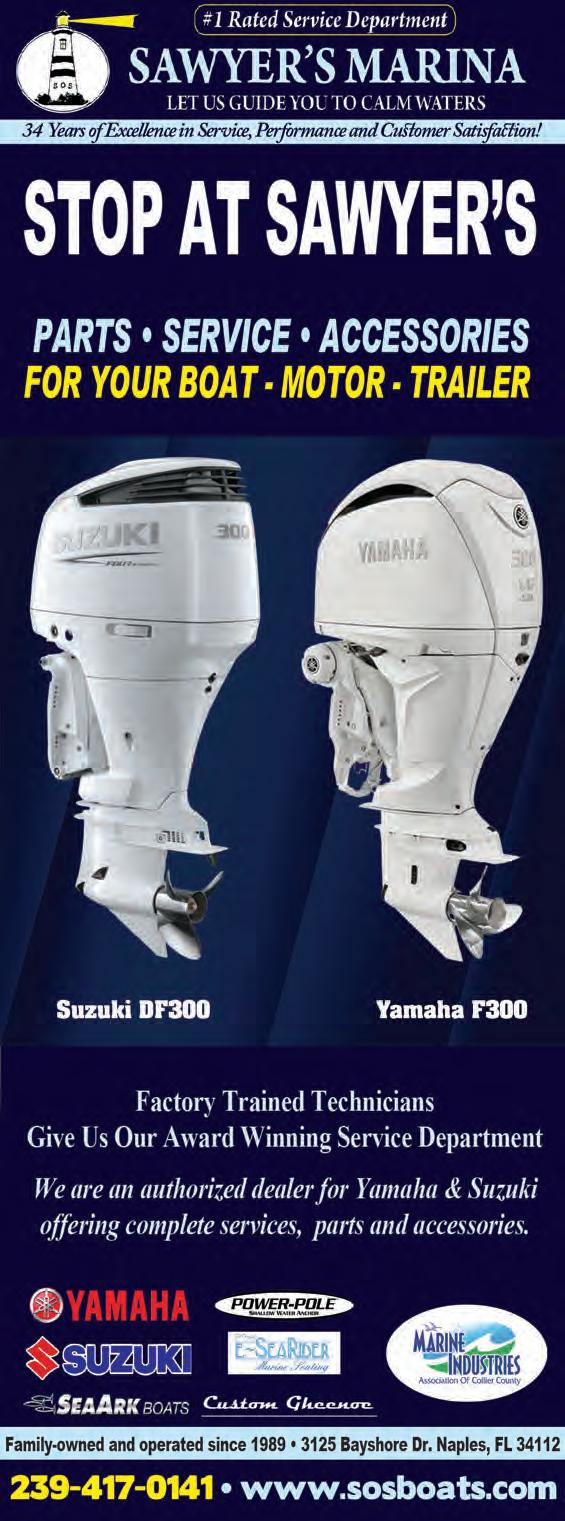
3















13
18
19
20
22
23
25
26
27






















































1
2




















18
19
20
21
22
23
26
27


















































By:

Depending on the weather this would be a great time to head offshore. Out in 100 feet of water you may encounter some nice size yellow tail snapper. Find an artificial reef and get anchored up on it so you may chum and pull the fish away from the structure. While you are chumming have some rods ready with just a hook and leader. This is when you need to be patient, you can put some baits down like squid or sardines and shrimp. This will keep you busy but continue to keep an eye on your chum and watch for the snapper to come up to the surface. This is when I’ll put a piece of cut bait on the rod with just a hook and drop it overboard. Leave your bail open and let the bait sink the same speed as your chum and watch the line as it comes off the spool. When the line starts to fly off your spool flip the bail, hold on, and when the line comes tight it will be a challenge to get the fish to the boat. Chumming attracts all types of fish including shark and barracuda. In our area, find some hard bottom or some small ledges you may even catch a keeper red grouper, and in a little closer to shore around 70 feet you may also get some lane snapper, porgies and white grunts. Closer to shore around 40 feet of water on some natural bottom you may find sheepshead and flounder. Depending on the migration of the bait fish you may find some spanish mackerel. Spanish mackerel get thick in the passes where you could setup a rig with a jig and a spoon. This is like a chicken rig just tie the jig on the shorter leader and a jig on the longer leader. This technique is very productive if you can see the schools feeding on the surface. I like to set up a couple of these rigs and troll them around the edges of the schools of feeding mackerel and as I work our way inshore there should be plenty of red action they may be under the mangroves or out on the flats in the sand holes waiting for an unsuspecting bait to swim by, where I will use some cut bait in the sand holes like fresh lady fish or even half of a crab and let them soak and they can smell that in the water. Give us a call if you would like to have a personal training session with Capt. Bart Marx and learn how we get it done!






by Capt. Billy Norris
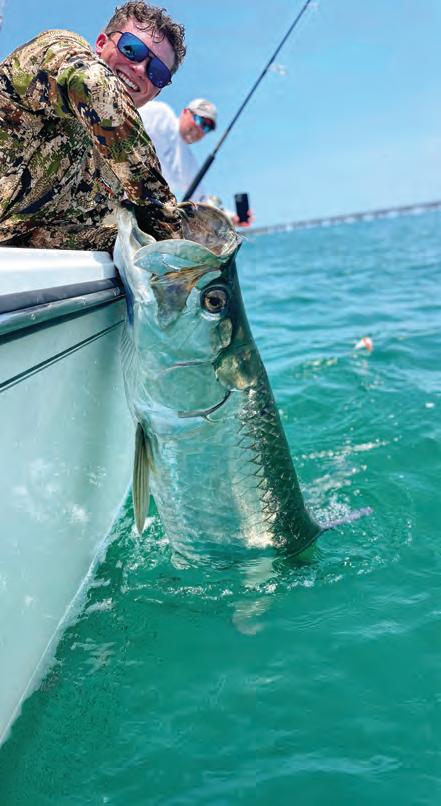
Tarpon are one of the most sought-after gamefish in the world. Drag screaming runs combined with aerial acrobatics make them a challenging fight for even the most skilled anglers. Whether its stalking them on shallow grass flats, chasing schools down the white sugar sand beaches, or targeting fish in current swept passes, tarpon fishing is one of the most addictive types of fishing Florida has to offer. Here are a few tips and tricks to help you improve your abilities when attempting to best the silver king.
Tarpon can be found in nearly every coastal aquatic environment in Florida. They inhabit reefs and wrecks, beaches, grass flats, estuaries and can even be found in freshwater lakes and ponds. Due to their wide-ranging habitats, your fishing style will change depending on where you’re fishing. Firstly, your gear and tackle have to be topnotch. Tarpon are one fish that will absolutely put your equipment to the test. If you have junk reels, frays in your line, cheap leader, or discount hooks, you will get whipped by these bruiser fish. Go over your setups from top to bottom, and make sure that everything that you are using is up to par. I prefer to use reels in the 60-80 range. Personally, I use Quantum Cabo 60s or Penn Slammer 7500 reels. The beefier reels are able to put the screws to the fish, and the larger spools allow you to carry a lot more line. A medium-heavy rod is also a big help when fighting tarpon. I use 7-foot medium action Star Rods. Now a days, it would be a challenge to find a professional captain who does not use braided line when tarpon fishing. I spool my reels up with 50-pound braid, but you can also up it to 80 if you’re targeting bigger fish.
Tarpon can be extremely picky when it comes to both baits and rigs. Fluorocarbon is an absolute must when it comes to your leaders and depending on the water quality, you may have to switch pound test if the fish are leader shy. 7 foot of 80-pound YoZuri pink fluorocarbon is where I typically start, but will bump down to 50 pound if the water is very clear. Everyone has their own preference of hooks, but I prefer either 8/0 Owner SSW Circles, or 6/0 Mustad UltraPoint Demon Circle hooks.
Believe it or not, tarpon will pretty much eat anything that lives in the ocean. I have caught them on cutbait, threadfins, crabs, pilchards, pinfish, discarded fish carcasses, literally almost everything. However, this does not mean that you can just use anything. Although they will consume a variety of baits, they are extremely picky and are notorious for getting dialed in on one specific type of prey. For example, when I’m fishing for tarpon in Marathon, I target two passes, Bahia Honda and the 7-Mile Bridge. Both passes are right next to each other, but at Bahia Honda the fish will only eat crabs and at 7-Mile they want mullet. It doesn’t seem to make any sense why two different schools so close to one another won’t eat the same things, but it is reality. Even the size of crabs that the fish will eat changes daily. Some days they will want small crabs, and other days larger ones. Crabs can be caught, but if you are purchasing them the cost can add up quickly. On average they retail for about $4-5 apiece, and on a day long tarpon trip I like to have at least 40 crabs of varying sizes. A good rule of thumb is you want crabs that are approximately the same width (across the carapace) as three of your fingers. Whether I’m using crabs, mullet, threadfins, etc., I will almost always freeline the bait, with the exception of sometimes using a cork to suspend the bait if needed. Being successful at hooking up tarpon comes from time put in on the water daily to figure out what they are eating at that particular time.
Now that your gear and equipment are ready, and your livewell is loaded with bait, it’s time to get hooked up! The most crucial part of landing tarpon is understanding how to fight them. They are notorious for throwing the hook when they make their world-famous jumps. You will consistently hear guides refer to “flying” X amount of tarpon. For example, when talking about the day of fishing you will hear me say something like “flew 5 landed 2”. This means that we hooked up with five fish but only got two boat side.
Only landing a small percentage of hooked fish is not uncommon, but the more practice you get the more you will land. Finally, you have to bow. Everyone who has even a slight bit of familiarity with tarpon has heard the old expression “bow to the king”. That means when the fish jumps, drop your rod tip. I actually tell my customers to stab the tip of the rod quickly into the water when they first see the fish rise to jump. This action puts slack in the line and will reduce breakoffs or the hook being pulled.
Tarpon fishing is without a doubt one of the most challenging and addictive type of fishing in the world. Hopefully I’ve helped to answer some of your questions surrounding the silver king, and help you to get out on the water and start landing some tarpon!
Captain Billy Norris is owner and operator of Pale Horse Fishing Charters in Bonita Springs, Florida. He guides the Southwest Florida area, and also operates tarpon charters out of Marathon in the Florida Keys during the month of May. You can contact him at (239)285-7710, or visit his website at www.PaleHorseFishingCharters.com.





















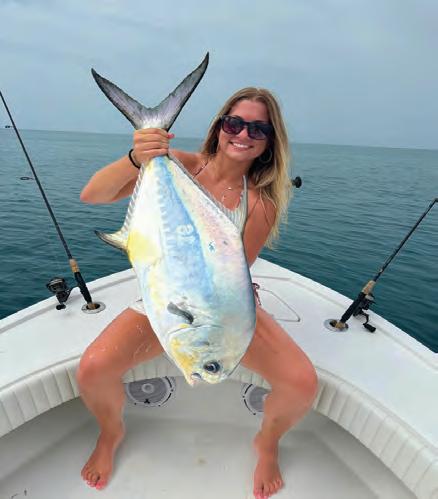
Beautiful


a nice sheepshead he caught off the Matlacha Bridge.
near shore in
Bay with Capt Brantley Witsken (Nov. catch).
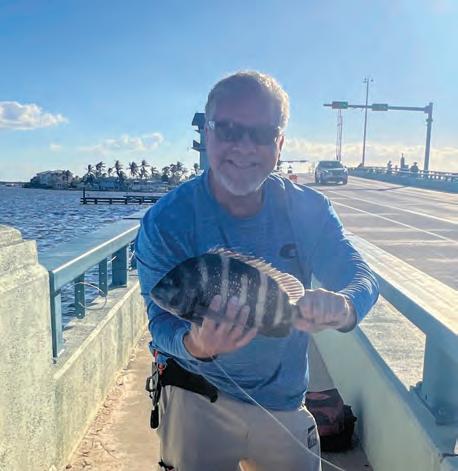










ShoreStation hydraulic boat lifts are a reliable choice for coastal residents and boating enthusiasts alike. Their strong construction, made with corrosion-resistant materials, allows them to withstand harsh environmental conditions, including sun, storms, and saltwater damage. ShoreStation provides a steadfast solution for protecting waterfront investments, o ering peace of mind to owners in the Sunshine State.
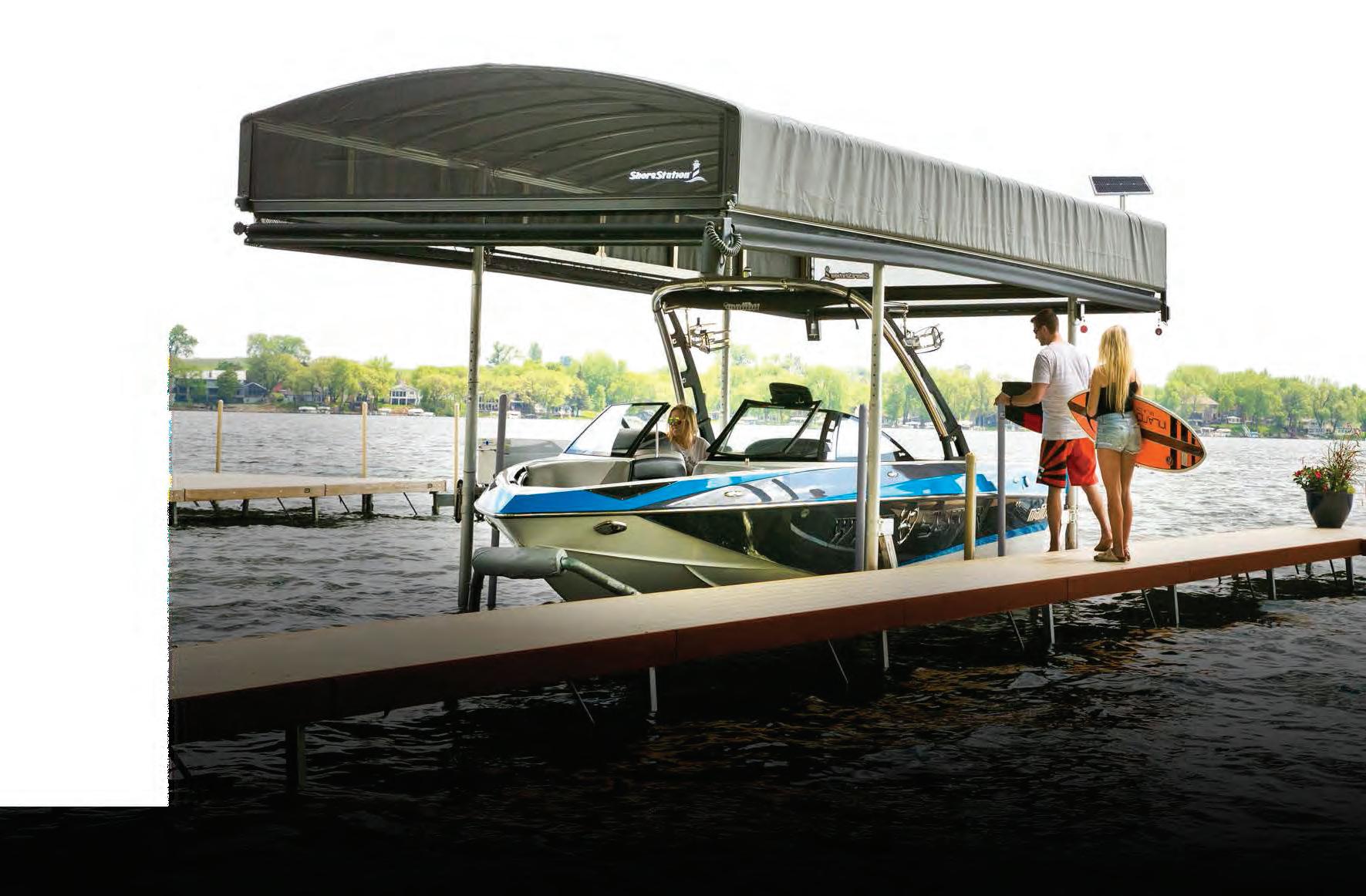







Equipped with exceptional weather resistant fabric and breathable SunTex 80 woven mesh ends for maximum protection and durability, the REVOLUTION™ Series Canopy is the most innovative canopy

Made from the highest quality materials, our innovative hydraulic boat lift is one of the fastest and safest lifts on the market today. When you have a hydraulic lift, there’s no need to worry about wind and waves getting in your way. This lift will give you con dence to safely land and secure your boat in less-than-ideal conditions.
Never miss another moment on the water. Power your lift with clean, free solar power. Our speedy 20 watt charger features solar regulator drainage protection, saving your battery from permanent damage caused by overcharging.



By Capt. Michael Okruhlik

Spring shing brings its own set of challenges and opportunities. As water temperatures rise, targeting inshore species like trout, ounder, and reds requires adapting to their changing behavior. Early spring o en means downsizing lures. As sh feed on tiny bait sh and shrimp, small lures mimic these natural prey more e$ectively. Large trout and reds may already have full stomachs, expelling small bait when caught, signaling the need for a smaller o$ering to match the size of the food they’re consuming.
With the warming water, sh become more aggressive, and it’s time to speed up your retrieval techniques. A er a slower winter, anglers should bring out faster-action rods and smaller versions of topwater and twitch baits. While spring can bring calm days, cool fronts and high-pressure systems still a$ect sh behavior. When this happens, adjusting to the conditions—rather than just relying on the calendar—is key. Opting for colors like white or silver for hard baits can pay o$ during this time.
However, spring also brings sti$ winds and crowds. In South Texas, gusts can reach up to 30 knots, making conditions challenging, especially

for kayakers. It’s crucial to check the forecast and plan for these challenging winds. Additionally, spring break brings an in ux of boaters and kayakers, many of whom may be rusty from the o$season. Defensive driving and boating have become essential, and leaving early is recommended to avoid congestion at ramps and on the roads.
Conditions are still variable when targeting sh in March. %e water can remain chilly despite warmer air temperatures. Cold fronts a$ect sh behavior, making them seek deeper water with more stable temperatures. While some sh may move closer to ats as the day warms, they rarely stray far from deep water. Focus on areas near the outer edges of guts that lead from deeper water to ats, adjusting as the day progresses.
During high-pressure conditions, downsizing lures remains reliable, especially as young forage species become abundant. Natural or translucent
colors work well; slowing the retrieval to keep lures closer to the bottom can increase success. When this approach doesn’t yield results, switching tactics can help. Using noisy lures, such as rattling crankbaits or loud topwaters, can provoke a reaction bite when sh are less willing to chase actively. Experimenting with these extremes—quiet, slow presentations versus noisy, aggressive ones—can help you nd the right approach in high-pressure situations. Spring shing requires patience, adaptability, and a keen eye for weather and water conditions. Whether you’re dealing with shi ing sh patterns or navigating spring break crowds, it’s a great time to get out on the water—and maybe bring a kid along for the adventure.
Capt. Michael Okruhlik is the inventor of Knockin Tail Lures®, and the owner of www.MyCoastOutdoors.com.



I’ve been incredibly blessed to !sh with some of the best anglers on the planet, guiding me through my journey. To complete that journey, I always keep a couple of rods in my truck, ready to !sh farm ponds, lakes, and rivers during my travels as a Boat Li US salesman. It brings me back to my roots.
Last month marked my 64th birthday, and I !nd myself enjoying the simple !shing of my youth more and more. Don’t get me wrong—I still love a gag grouper or wahoo bite like Peter loved our Lord—but I also love catching whatever is in season. March can be a slow month for nearshore and o shore !shing, making it the perfect time to switch focus to hickory and white (American) shad in our rivers.
Tim Barefoot

their birth. eir migration mirrors that of Paci!c salmon, using an innate
learning their seasons over the years. Hickory shad arrive !rst—smaller but plentiful—making them perfect for introducing kids to !shing with non-stop action. When the larger white shad show up, it’s game on. ese !sh pull hard in the cold water, !ghting until the moment you unhook them.
I strongly recommend mashing down the barbs on your hooks to make dehooking easier. Let’s be honest—most anglers aren’t eating shad, so reducing injury before release just makes sense. Also, always wear eye protection when !shing for these powerful !sh. A jig popping free near the boat can come ying back at the angler, as my son learned the hard way in a recent trip to the James River.

ese !sh are truly amazing. ey leave the coastal rivers of the eastern U.S., migrate to Nova Scotia, take a hard right into deep waters, then journey back south to spawn in the rivers of
GPS to !nd their way home. ey travel in vast schools, surviving intense predation, just to return to their spawning grounds.
Knowing this, I position myself to take full advantage of this mass migration. I !sh for shad in Virginia, North Carolina, and South Carolina,
White shad will be in rivers all the way down to Florida this month, so if you’re looking for a fun !ght on light tackle, now is the time. Check out my YouTube channel for the tackle and techniques I use to catch these childhood favorites. And, as always, take plenty of videos of your kids—they’ll cherish those memories later in life.
For more from Tim Barefoot, visit barefootcatsandtackle.com and check out his YouTube channel.












May 9th & 10th, 2025
Online Registration: MothersDayDolphinTournament.com
Captain’s Meeting
Liechty Marine
Friday May 9th - 6pm to 7pm
Lines In: Saturday, May 10 - 7:30am
Lines Out: Saturday, May 10 - 3:30pm
Weigh-In
Curly’s Co ee
Saturday, May 10th - 3:30pm to 6pm
Awards Banquet
Marathon Yacht Club
Saturday, May 10th - 7pm
Sunday Honor




















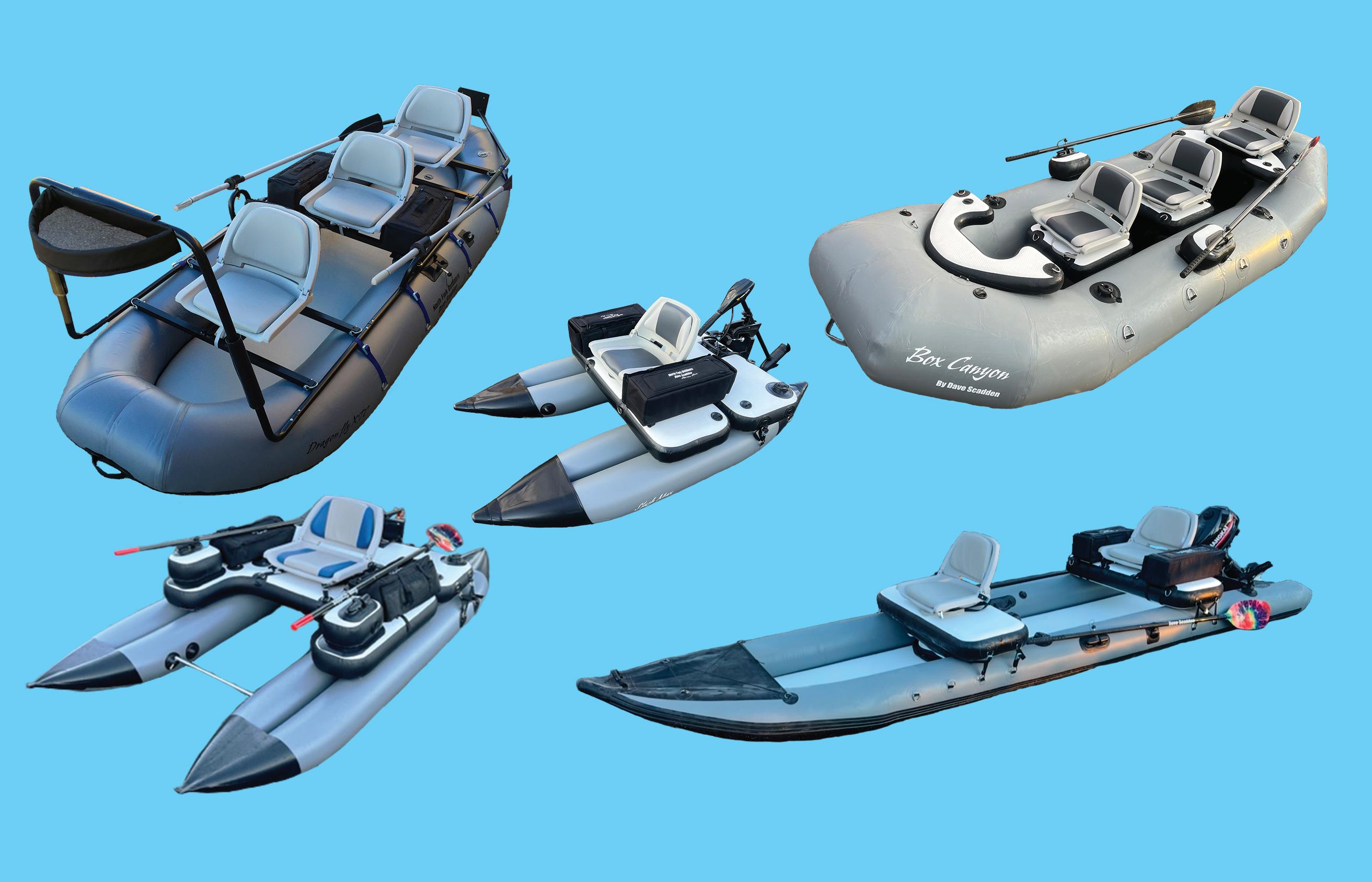










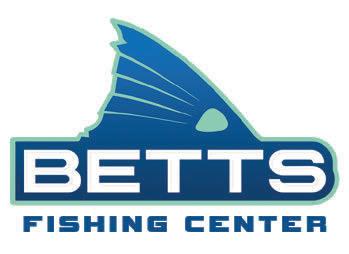


From February through April, bass ood the shallows to spawn, creating an exciting opportunity for anglers to catch monster !sh. While various techniques can be e ective, !shing with a big worm consistently tempts big, wary females. is method has proven successful nationwide, not just in the South.
Fishing a worm may not be the most thrilling technique, but it allows for a slow, precise presentation—ideal for enticing cautious bass. e key is patience and targeting highpercentage areas where these !sh are likely holding.
One e ective technique is casting a Texasrigged stick bait. Many anglers waste time on unproductive water, but focusing on isolated cover—small patches of grass, pads, wood, or rock structures—maximizes success. A 6” worm in darker colors like black-and-blue works well, paired with a 1/16 oz or 1/8 oz weight for a natural presentation. Given the thick cover, 17-20 lb uorocarbon is ideal for strength and stealth.
Another productive method is retrieving a big speed worm. is subtle, vibrating motion excites bass and helps locate !sh before slowing down for precision tactics. In stained water, darker shades like June bug work best, while

TYLER WOOLCOTT

green pumpkin with ake is ideal for clear water. A 1/8 oz to 1/4 oz weight with 15-17 lb uorocarbon balances presentation and control.
e wacky rig is highly e ective in shallow water, particularly for pressured bass. is weightless presentation targets isolated cover, making it a deadly !nesse option. A 10-15 lb uorocarbon leader on a spinning setup provides the necessary balance of stealth and strength. As with other worm techniques, darker colors suit stained water, while natural tones excel in clear conditions.
Flipping a worm is less stealthy but allows precise bait placement in thick cover, such as pad !elds, wood, or dense grass. is method is excellent for working through cover quickly while thoroughly breaking down key sections. Using large Senko-style baits and braided line ensures maximum strength. Weight selection varies from 3/8 oz to 3/4 oz, depending on cover density. Slowing down and targeting overlooked spots can set you apart from other anglers.
Rod and reel choices remain fairly consistent across these techniques. For casting and ipping, a 7’6” medium-heavy to heavy action rod, such as the 13 Fishing Omen Series, paired with a high-speed baitcasting reel like the Concept

A 7:5:1, ensures control and power. For wacky rigs, a 7’3” medium-heavy spinning rod with a quality reel like the 13 Fishing Axum provides sensitivity and strength.
ese big worm techniques have helped me land giants during the spawn, and I hope they do the same for you. Whether !shing Florida’s grass beds or rocky northern structures, these methods are time-tested and e ective. Get out there this spring and hook into some monster bass!
Tyler Woolcott is a professional tournament angler and guide. Check out his website at www.tylerwoolcott shing.com.
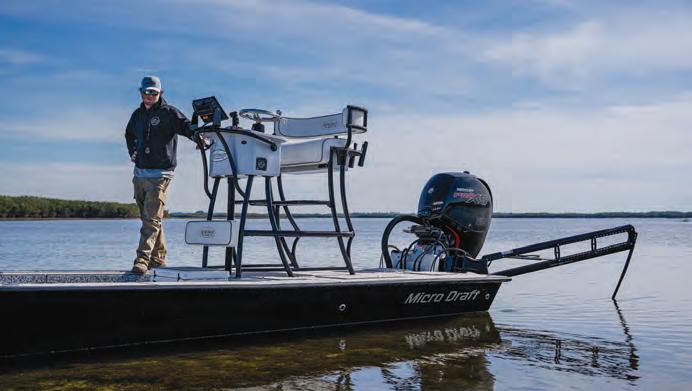




















In the misty Scottish Highlands, where mountains meet shimmering lochs, the dirk dagger has been a symbol of heritage and honor for centuries. Originating in the medieval battles and clan rivalries, these daggers were not just weapons but treasured heirlooms passed through generations.
One stormy night, a young warrior named Ewan was called to the forge by his grandfather, Duncan, a revered blacksmith. “Ewan,” he began, “our clan’s strength lies not only in our courage but in the blades we wield. Tonight, you will learn the art of crafting a dirk that will carry our legacy forward.”
Ewan selected premium Damascus steel, layering it over 242 times to create a blade with intricate, swirling patterns reminiscent of ancient Highland rivers. Each fold whispered stories of battles won and lost, of honor and sacrifice. He crafted a classic spear point blade with a ¾ tang for enhanced strength and balance, ensuring it stood the test of time and combat.


The handle was crafted from solid Micarta, a material as resilient as the Scottish spirit. Adorned with stainless steel and brass file work, the spacers and guard shimmered like northern stars. The rounded pommel provided perfect balance and a textured grip, making it feel like an extension of Ewan’s hand.
As dawn broke, Ewan held the completed dirk in his hands. Measuring 12 inches overall, with a 7-inch blade, it was more than a weapon; it was a tribute to his ancestors and a beacon of his clan’s legacy.


Ewan’s dirk became legendary, said to cut through the strongest armor, with patterns holding the essence of the Highlands. Today, the Damascus Spiral Dirk Knife stands as a pinnacle of craftsmanship, a modern marvel carrying the spirit of ancient Scottish warriors. It is a legacy reborn, ready to be part of your collection, where every inch tells a story of dedication, tradition, and excellence.
Embrace the legend. Hold the history. Own the Damascus Spiral Dirk Knife today for just $99 plus S&H when using special offer code CA5MDK at checkout. This offer is limited to the first 1,200 orders so be sharp and call up today!
Specifications:
Overall Length: 12”
Blade Length: 7”
Blade Material: Premium Damascus steel, layered over 242 times Tang: ¾ tang for enhanced performance
Handle Material: Solid Micarta with stainless steel and brass file, worked spacers and guard Pommel: Rounded for balance and ergonomic grip
Damascus Spiral Dirk Dagger Knife
Was - $249
Now Only - $99 (plus S&H)
Use o er code: CA5MDK
*California residents please call 1-800 733 8463 regarding Proposition 65 regulations before purchasing this product.





